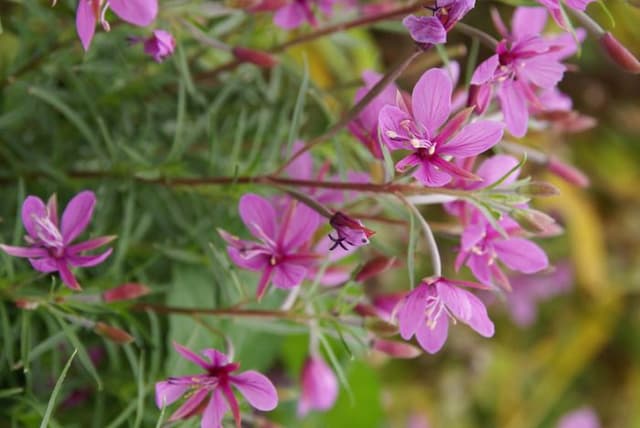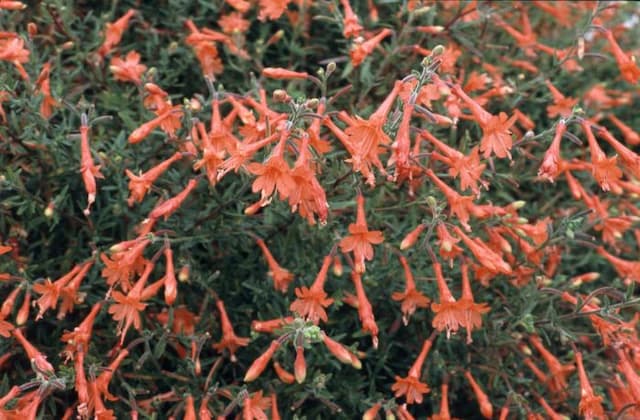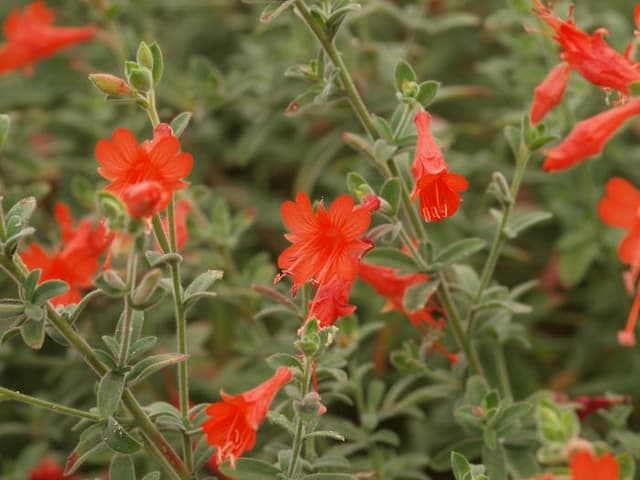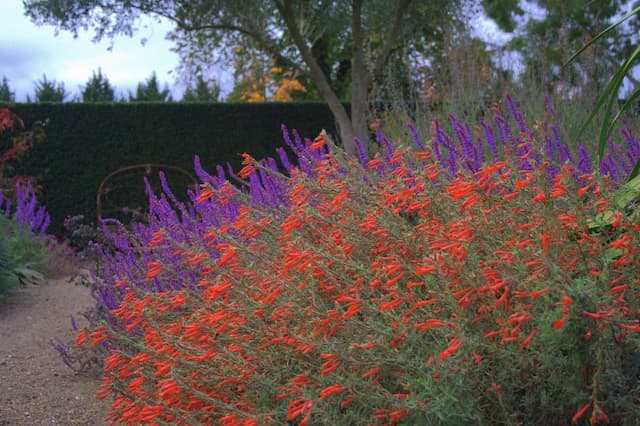Fuchsia Fuchsia 'Beacon Rosa'

ABOUT
Fuchsia 'Beacon Rosa' is a striking, ornamental plant renowned for its distinctive and vibrant flowers. The blooms of 'Beacon Rosa' are particularly eye-catching, with their unique pendant shape, often resembling dangling earrings. The blossoms are composed of a combination of vivid pink and purple hues, with the outer petals often displaying a lighter pink shade, while the inner skirt-like petals exhibit a rich, purplish tone. These inner petals also typically curve inwards, creating an elegant and intricate floral display. The foliage of 'Beacon Rosa' provides a lush backdrop for the spectacular flowers. The leaves are typically green, and their texture may range from smooth to slightly veined, displaying a nice contrast to the softness of the petals. The stems of the plant are typically slender and may have a trailing or cascading habit, adding to the plant's graceful appearance. The overall aesthetic of 'Beacon Rosa' makes it a popular choice for gardeners who wish to add a splash of color and a touch of exotic appeal to their garden spaces. Keep in mind that 'Beacon Rosa' can have various appearances depending on how it is cultivated—whether in hanging baskets, containers, or garden beds—each method can influence the way the plant presents itself, particularly concerning its form and the way its flowers are displayed.
About this plant
 Names
NamesSynonyms
Fuchsia, Ladies' Eardrops, Beacon Rosa Fuchsia.
Common names
Fuchsia 'Beacon Rosa'.
 Toxicity
ToxicityTo humans
Fuchsia, including the variety 'Beacon Rosa', is generally considered non-toxic to humans. It is not known to cause serious illness or pose significant health risks if ingested. However, it is always advisable to avoid eating ornamental plants as they are not intended for consumption, and individual sensitivities can vary.
To pets
Fuchsia, like the 'Beacon Rosa' variety, is typically not toxic to pets. It is not expected to cause serious harm if pets nibble on the leaves or flowers. That said, precaution should be taken to prevent pets from eating plants as they might still cause mild gastrointestinal upset due to individual sensitivity or if consumed in large quantities.
 Characteristics
CharacteristicsLife cycle
Perennials
Foliage type
Deciduous
Color of leaves
Green
Flower color
Pink
Height
1-2 feet (30-60 cm)
Spread
1-2 feet (30-60 cm)
Plant type
Shrub
Hardiness zones
9
Native area
Central and South America
Benefits
 General Benefits
General Benefits- Attractive Flowers: Fuchsia 'Beacon Rosa' produces beautiful, pendulous flowers that are a draw for garden enthusiasts and can enhance the visual appeal of any garden space.
- Long Blooming Season: This plant typically has a long flowering period, providing color and interest in the garden for an extended time.
- Pollinator Friendly: The flowers of Fuchsia 'Beacon Rosa' are popular with pollinators such as bees, butterflies, and hummingbirds, encouraging biodiversity.
- Versatility: It can be grown in pots, hanging baskets, or beds and borders, making it a versatile choice for many garden layouts.
- Shade Tolerance: Unlike many other flowering plants, Fuchsia 'Beacon Rosa' can thrive in partial shade, giving gardeners more planting location options.
 Medical Properties
Medical PropertiesThis plant is not used for medical purposes.
 Air-purifying Qualities
Air-purifying QualitiesThis plant is not specifically known for air purifying qualities.
 Other Uses
Other Uses- Fuchsia 'Beacon Rosa' can be used to create natural dyes for fabrics, with the petals and berries yielding different shades.
- When dried and crushed, the petals of the Fuchsia can be incorporated into homemade paper to add texture and color.
- The colorful flowers can be used in pressed flower art, as they retain their vibrant colors well after being pressed and dried.
- The nectar-rich blossoms are ideal for attracting hummingbirds to your garden, providing natural bird watching opportunities.
- Fuchsia branches can be shaped and trained over time to form intricate living sculptures in a practice known as topiary.
- Small-scale Fuchsia plants can be used in fairy gardens to create a whimsical, miniature landscape ideal for container gardening.
- Fuchsias can be employed as temporary seasonal hedges in mild climates, adding a vibrant splash of color to garden borders.
- Surplus Fuchsia flowers can be frozen in ice cubes to create eye-catching additions for summer beverages and cocktails.
- Fuchsia 'Beacon Rosa' can serve as a natural indicator of soil pH; the color of the flowers can suggest the acidity or alkalinity of the soil they are grown in.
- These plants can be used in educational settings to teach about plant biology and the interaction between pollinators and flowers.
Interesting Facts
 Feng Shui
Feng ShuiThe Fuchsia is not used in Feng Shui practice.
 Zodiac Sign Compitability
Zodiac Sign CompitabilityThe Fuchsia is not used in astrology practice.
 Plant Symbolism
Plant Symbolism- Confiding Love: The fuchsia flower, generally, is often associated with confiding love. Its hanging blooms resemble earrings, adding a sense of delicate intimacy to its symbolism.
- Elegance and Good Taste: Due to its elegant drooping flowers and striking color combination, fuchsias are often used to symbolize good taste and a sense of refinement.
- Overflowing Abundance: The profuse flowering and fast-growing nature of the plant reflect an overflowing abundance, making it symbolic of generosity and a wealth of love or affection.
- Trust: Fuchsia can symbolize trust in a relationship, whether it's romantic or platonic, signifying the depth and security in longstanding bonds.
- Amiability: With its inviting shape and vivid colors, the plant often represents amiability or warm-heartedness, making it a friendly and welcoming gesture in gardens.
 Water
WaterFuchsia 'Beacon Rosa', commonly known as Hardy Fuchsia, prefers consistently moist soil but not waterlogged conditions. During the growing season, water the plant deeply once or twice a week, providing about 16-32 ounces of water each time, depending on the weather and soil drainage. Reduce watering in the winter when the plant is dormant but do not allow the soil to completely dry out. Always check the top inch of soil for dryness before watering again to ensure you're not overwatering.
 Light
LightHardy Fuchsia thrives in bright, indirect light with protection from the harsh afternoon sun. The ideal spot for this plant would be an east or north-facing location where it can receive morning sunlight and shade during the more intense afternoon hours. Avoid placing it in deep shade, as this can reduce flowering.
 Temperature
TemperatureHardy Fuchsia fares well in a temperature range of 60-76 degrees Fahrenheit. It can survive minimum temperatures down to around 40 degrees Fahrenheit, but frost can damage the plant. The maximum temperature should not exceed 85 degrees Fahrenheit for extended periods, as excessive heat can stress the plant.
 Pruning
PruningPrune Hardy Fuchsia in the spring to maintain its shape, remove dead or weak growth, and encourage bushier growth and more flowers. Pruning should be done annually, and the best time for this is just before new growth begins after the last expected frost. Additionally, deadheading spent flowers throughout the growing season can also promote continuous blooming.
 Cleaning
CleaningAs needed
 Soil
SoilFuchsia 'Beacon Rosa', commonly known as Hardy Fuchsia, thrives in a soil mix that is moist, well-draining, and rich in organic matter. A good mix can be created by combining loam or a peat-based potting compost with perlite or sand to improve drainage. The ideal soil pH for Hardy Fuchsia is slightly acidic to neutral, ranging from 6.0 to 7.0.
 Repotting
RepottingHardy Fuchsia should be repotted every 2-3 years or when the plant becomes root-bound. The best time for repotting is in the late winter or early spring, before the onset of the new growing season.
 Humidity & Misting
Humidity & MistingHardy Fuchsia prefers a humid environment, with the best humidity level for the plant being around 60-70%. This creates optimal conditions for its growth, particularly during the warmer months when indoor air can become dry.
 Suitable locations
Suitable locationsIndoor
Ensure bright, indirect light and maintain cooler temps for Hardy Fuchsia.
Outdoor
Plant in partial shade, sheltered spot, and protect from frost for Hardy Fuchsia.
Hardiness zone
6-11 USDA
 Life cycle
Life cycleFuchsia 'Beacon Rosa', commonly known as hardy fuchsia, begins its life as a seed, which when sown, emerges as a seedling with characteristic fleshy leaves. As it grows, it enters the vegetative stage, developing a bushy structure with bright green, ovate leaves on arching stems. The next stage is the flowering period, where it produces pendulous, teardrop-shaped flowers, usually in shades of pink and purple, attracting pollinators such as hummingbirds and bees. After pollination, the flowers develop into small, oval fruits containing seeds for the next generation. The plant then goes into a dormant phase during the colder months, shedding leaves and remaining inactive until temperatures rise. With the return of warmer weather, the plant resumes growth and starts the cycle anew, often living for several years when cared for properly.
 Propogation
PropogationPropogation time
Spring to summer
The most popular method of propagation for Fuchsia 'Beacon Rosa', commonly known simply as fuchsia, is through stem cuttings. Typically, the best time to take cuttings is in spring or early summer, when the plant is actively growing. Cut a 2-4 inch length (about 5-10 cm) of stem, just above a set of leaves. Remove the lower pairs of leaves, leaving just the top few, to reduce moisture loss. Dip the cut end into rooting hormone powder to encourage root growth. Plant the cutting in a pot filled with a mixture of peat and perlite, making sure to keep the soil moist but not waterlogged. Place the pot in a bright area with indirect sunlight and maintain a consistent temperature of around 65-75 degrees Fahrenheit (about 18-24 degrees Celsius), and within a few weeks, the cutting should develop roots and can be transplanted.









